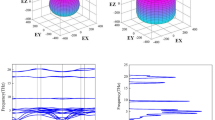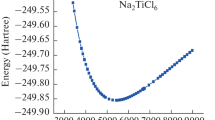Abstract
The first principles study is performed for the mechanical strength of Kevlar-29, and is based on density functional theory. The bond strength is investigated relative to the displacement of central nitrogen atom along X, Y and Z directions, respectively. The structural property analysis explains the asymmetric nature. A higher bond breaking energy is observed during compression along Z direction and vice versa for elongation. It is an insulator of forbidden energy gap which increases while compression and reduces during elongation. Crystal orbital overlap population reveals the higher strength of anti-bonding orbitals. It is mechanically stronger along the Z-axis and weaker along the Y-axis.
Graphical abstract







Similar content being viewed by others
References
Hindeleh A M and Abdo S M 1989 Polymer 30 218
Hindeleh A M and Abdo S M 1989 Polym. Commun. 30 184
Hancox N 1993 Mater. Design 14 312
Fink J K 2008 High performance polymer (Norwich: William Andrew Inc.) p 423
Downing J W and Newell J A 2004 J. Appl. Poly. Sci. 91 417
Hongu T, Phillips GO and Takigami M 2005 New millennium fibers (USA: Woodhead Publishing) p 299
Yang H H 1993 Kevlar aramid fiber (New York: John Wiley & Sons Inc.)
Wortmann F J and Schulz K V 1995 Polymer 36 2363
Jacobs M J N and Dingenen J L J V 2001 J. Mater. Sci. 36 3137
Rao M P, Duan Y, Keefe M, Powers B M and Bogetti T A 2009 Compos. Struct. 89 556
Duan Y, Keefe M, Bogetti T A and Cheeseman B A 2005 Int. J. Impact. Eng. 31 996
Duan Y, Keefe M, Bogetti T A and Powers B 2006 Int. J. Mech. Sci. 48 33
Gu B 2004 J. Compos. Mater. 38 2049
Ha-Minh C, Kanit T, Boussu F and Imad A 2011 J. Comput. Mater. Sci. 50 2172
Li T T, Wang R, Lou C W and Lin J H 2014 Composites, Part B 59 60
Singh T J and Samanta S 2015 Mater. Today Proc. 2 1381
Bandaru A K, Chavan V V, Ahmad S, Alagirusamy R and Bhatnagar N 2016 Int. J. Impact Eng. 93 136
Aamir M and Yu M 2015 Int. J. Sci. Res. Publ. 5 2250
Woo S C and Kim T W 2014 Composites, Part B 60 125
Wortmann F J and Schulz K V 1995 J. Poly. 36 2363
Pregoretti A, Traina M and Bunsell A R (eds) 2009 Handbook of tensile properties of textile and technical fibers (Cambridge: Woodhead Publishing Limited) p 354
Hohenberg P and Kohn W 1964 Phys. Rev. 136 B864
Solar M et al 2002 J. Phys.: Condens. Matter 14 2745
Perdew J P and Burke K 1996 J. Phys. Rev. Lett. 77 3865
Trouillier N and Martins J L 1991 J. Phys. Rev. B 43 1993
Junquera J, Paz O, Portal D S and Artacho E 2001 J. Phys. Rev. B 64 235111
Shen C, Wang J, Tang Z, Wang H, Lian H, Zhang J et al 2009 Electrochim. Acta 54 3490
Cisnerosa J A B, Ochoaa A T, Estradab J A G, Ramírezc C A H, Macíasa A H, Sáncheza R M et al 2012 J. Alloys Compd. 536S S456
Verma M L, Rao B K, Singh R, Banchor D and Sahu H D 2017 J. Ionics 23 2715
Matar S F, Pottgen R, Alam A F A and Ouaini N 2012 Chem. Phys. Lett. 5 75
Hughbanks T and Hoffmann R 1983 J. Am. Chem. Soc. 11 3528
Lin L Y, Ying Z, Jie H R and Hong L G 2009 Chim. Phys. B 5 1923
Bresciani L M, Manes A, Ruggiero A, Iannitti G and Giglio M 2016 Composites, Part B 88 114
Ahmed D, Hongpeng Z, Haijuan K, Jing L, Yua M and Muhuo Y 2014 Mater. Res. 17 1180
Acknowledgements
The authors gratefully acknowledge the management of Shri Shankaracharya Technical Campus-SSGI for the computing facility in the research laboratory. The first and third authors acknowledge the kind support of the Department of Mechanical Engineering, BIT, Durg.
Author information
Authors and Affiliations
Corresponding author
Rights and permissions
About this article
Cite this article
Verma, H., Rao, B.K., Verma, M.L. et al. First principles study of breaking energy and mechanical strength of Kevlar-29. Bull Mater Sci 42, 76 (2019). https://doi.org/10.1007/s12034-019-1747-y
Received:
Accepted:
Published:
DOI: https://doi.org/10.1007/s12034-019-1747-y




